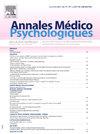La catatonie progressive par accès périodiques ou « catatonie périodique » de Karl Leonhard. 1er partie. Description du phénotype et diagnostic neuropsychiatrique
IF 0.5
4区 医学
Q4 PSYCHIATRY
引用次数: 0
Abstract
While the correlation between the phenotype of periodic catatonia and two biomarkers, one genetic and the other brain imaging, has attracted the attention of international psychiatry, there has been little clinical or etiopathological research on this phenotype. The main reason is probably that this phenotype described by the Wernicke-Kleist-Leonhard (WKL) school has been defined in a paradigmatic framework so far removed from that of the ICD or DSM, and that even its name is problematic. Here, ‘periodic catatonia’ has nothing to do with a simple recurrence of relapsing-remitting ICD-catatonia. Hence, we will refer to it as ‘periodic catatonia by progressive access’ (PCPA) to distinguish it from remitting forms. In PCPA, catatonic manifestations are often inconspicuous, and more than half of the patients advance in a step-like progression towards a kind of disabling ‘deficit schizophrenia’. Preliminary results indicate that this symptomatology, which is usually resistant to psychopharmacological treatments, could respond to a personalized neuromodulation treatment specific to PCPA. This is what a national study seeks to confirm in France. In this context, this two-part article aims to make those psychiatrists who have been trained in ICD/DSM psychopathology aware of PCPA and to enable them to diagnose it correctly. The objective of this article is therefore twofold. In the first part, it seems essential to present the problem. PCPA is a product of systems neuropsychiatry, whose diagnostic approach is at odds with the atheoretical and polythetic approach of the international classifications. This first part is intended to present an idea of the diagnostic procedure and to stress the impossibility of diagnosing ‘periodic catatonia’ without reference to its conceptual framework. This is emphasized by changing the name: PCPA is not periodic catatonia, but an operationalization of the original concept. PCPA is intended to be sharable without recourse to a theoretical corpus which is not universally accepted. Therefore, we will describe PCPA using ICD-11 terminology to present an overall picture of the symptomatology and to introduce the elements on which it will be possible to rely when performing the probabilistic diagnosis that will be presented in part II.
卡尔·莱昂哈德的《通过周期性访问的渐进式紧张关系》,第一部分。表型描述与神经精神病学诊断
虽然周期性紧张症的表型与两种生物标志物(一种是遗传的,另一种是脑成像的)之间的相关性引起了国际精神病学的关注,但对这种表型的临床或病因学研究很少。主要原因可能是Wernicke-Kleist-Leonhard (WKL)学派所描述的这种表型是在一个范式框架中定义的,与ICD或DSM相去甚远,甚至它的名字都有问题。在这里,“周期性紧张症”与复发-缓解型icd紧张症的简单复发无关。因此,我们将其称为“进行性紧张症”(PCPA),以区别于缓解型紧张症。在PCPA中,紧张性表现通常不明显,超过一半的患者以阶梯状的进展向一种致残的“缺陷精神分裂症”发展。初步结果表明,这种通常对精神药理学治疗有抗性的症状可能对PCPA特异性的个性化神经调节治疗有反应。法国的一项全国性研究试图证实这一点。在这种情况下,这篇两部分的文章旨在使那些接受过ICD/DSM精神病理学培训的精神科医生了解PCPA,并使他们能够正确诊断PCPA。因此,本文的目的是双重的。在第一部分,似乎有必要提出这个问题。PCPA是系统神经精神病学的产物,其诊断方法与国际分类的理论和综合方法不一致。第一部分旨在介绍诊断程序的概念,并强调在不参考其概念框架的情况下诊断“周期性紧张症”的不可能性。通过更改名称来强调这一点:PCPA不是周期性紧张症,而是对原始概念的操作化。PCPA旨在是可共享的,而不依赖于没有被普遍接受的理论语料库。因此,我们将使用ICD-11术语来描述PCPA,以呈现症状学的整体图景,并介绍在执行将在第二部分中呈现的概率诊断时可能依赖的要素。
本文章由计算机程序翻译,如有差异,请以英文原文为准。
求助全文
约1分钟内获得全文
求助全文
来源期刊

Annales medico-psychologiques
医学-精神病学
CiteScore
1.30
自引率
33.30%
发文量
196
审稿时长
4-8 weeks
期刊介绍:
The Annales Médico-Psychologiques is a peer-reviewed medical journal covering the field of psychiatry. Articles are published in French or in English. The journal was established in 1843 and is published by Elsevier on behalf of the Société Médico-Psychologique.
The journal publishes 10 times a year original articles covering biological, genetic, psychological, forensic and cultural issues relevant to the diagnosis and treatment of mental illness, as well as peer reviewed articles that have been presented and discussed during meetings of the Société Médico-Psychologique.To report on the major currents of thought of contemporary psychiatry, and to publish clinical and biological research of international standard, these are the aims of the Annales Médico-Psychologiques.
 求助内容:
求助内容: 应助结果提醒方式:
应助结果提醒方式:


